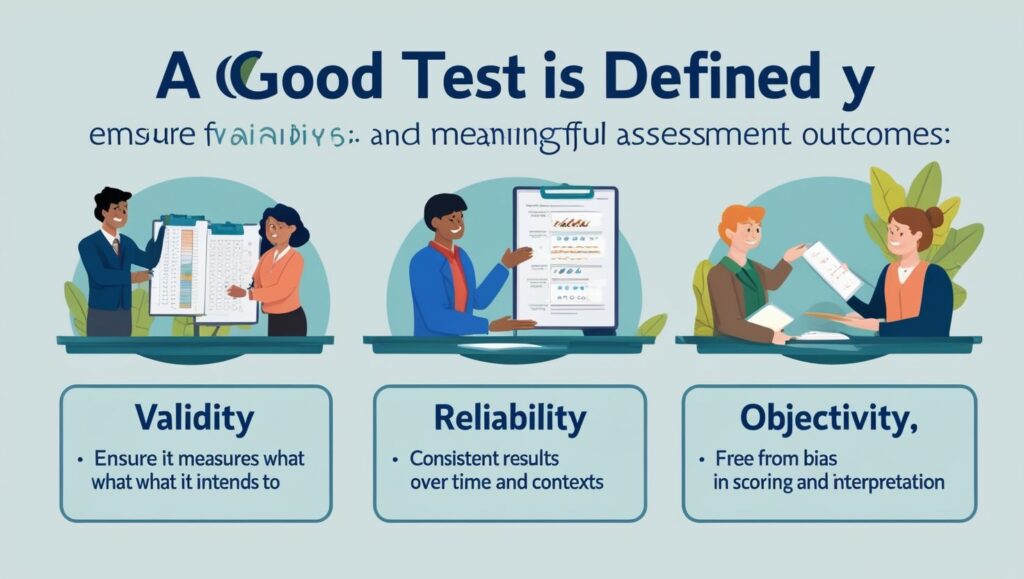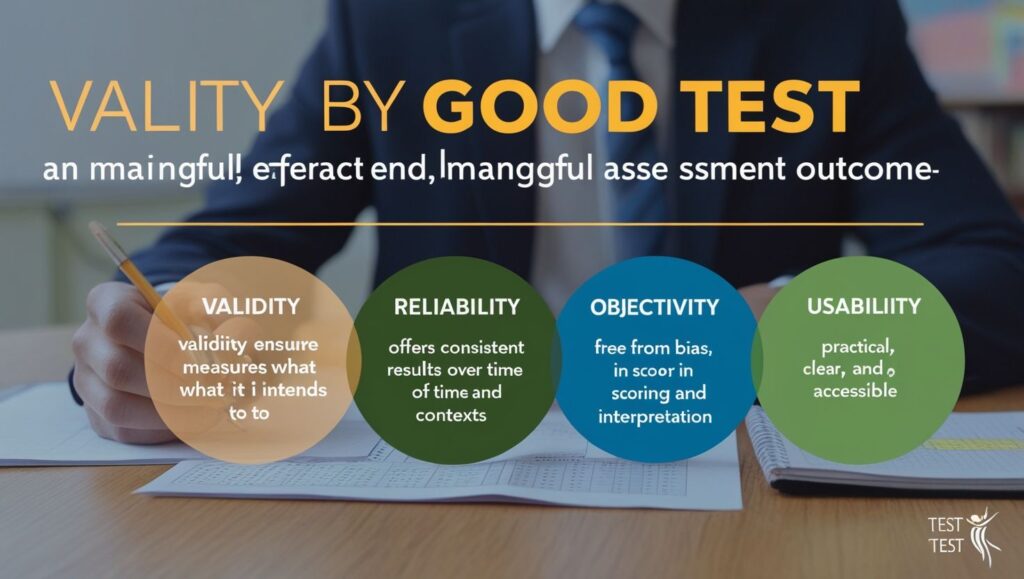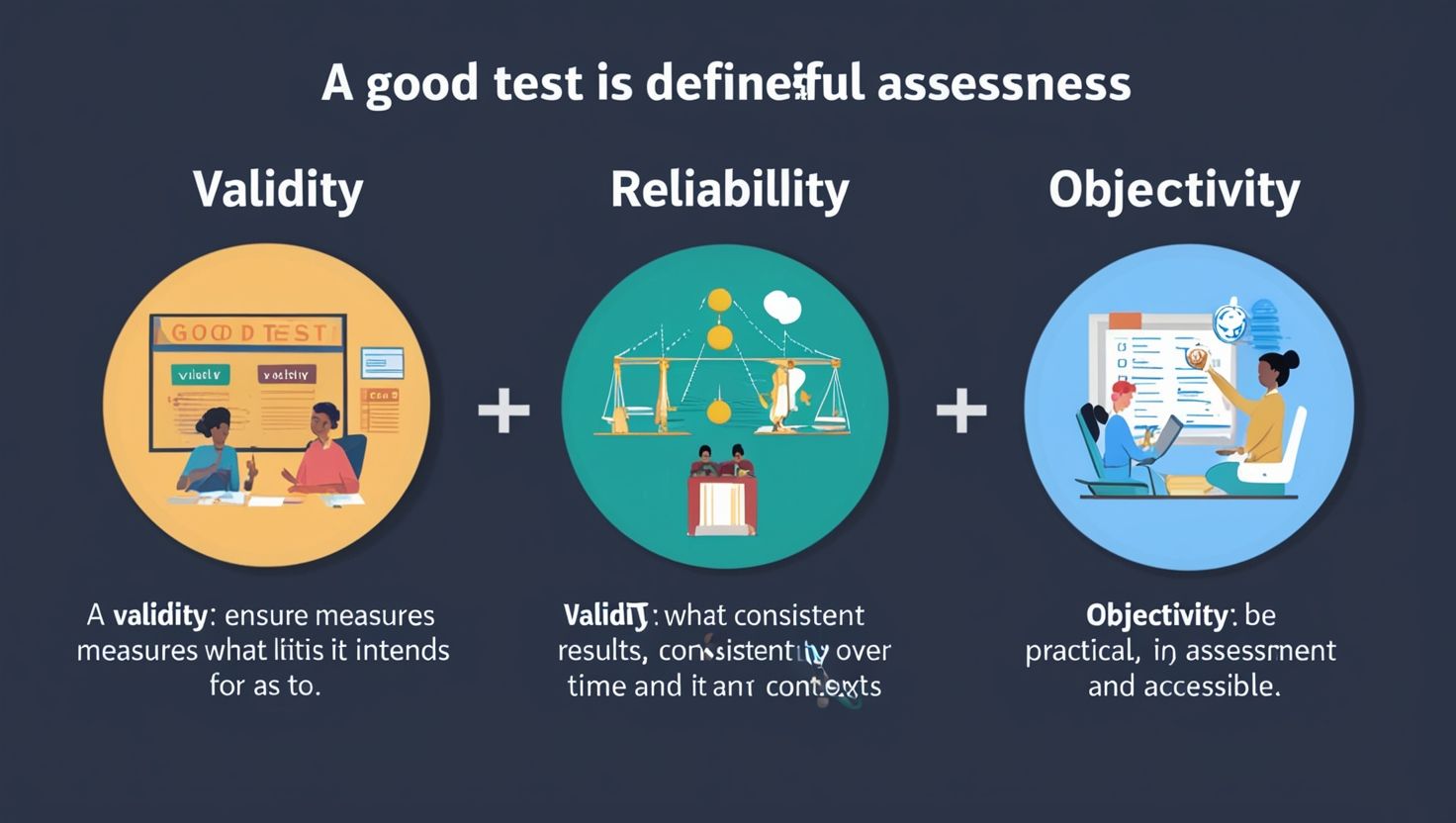Introduction
Characteristics of a Good Test, Assessment and evaluation form integral aspects of the educational process, with testing as a key tool for gauging knowledge, skills, and competencies. The effectiveness of a test depends on its ability to accurately reflect the objectives for which it was designed. This effectiveness is evaluated through four fundamental characteristics: validity, reliability, objectivity, and usability. Understanding these characteristics ensures that tests serve their intended purposes effectively and ethically.
1. Validity
Validity refers to the extent to which a test measures what it claims to measure. It is the most critical aspect of a test, as it ensures that the results derived from the test align with the intended objectives.
Types of Validity
- Content Validity: Ensures that the test covers the entire content domain it aims to assess. For example, a mathematics test must include a balanced representation of algebra, geometry, and arithmetic as outlined in the curriculum.
- Construct Validity: Measures whether the test truly assesses the psychological construct it is designed for, such as intelligence, creativity, or motivation.
- Criterion-Related Validity: Determines how well a test’s results correlate with another established measure. This includes:
- Predictive Validity: Assesses the test’s ability to predict future performance (e.g., SAT predicting college success).
- Concurrent Validity: Compares the test’s results with those from an already validated instrument.
Importance of Validity
- Ensures alignment with learning goals.
- Enhances the credibility of the test in decision-making.
- Reduces biases and misinterpretations.
Challenges to Validity
- Ambiguously worded questions.
- Misalignment between test items and objectives.
- Cultural or language biases that affect interpretation.
2. Reliability
Reliability refers to the consistency and stability of test results over time and across different conditions. A reliable test will yield similar results under consistent circumstances.
Types of Reliability
- Test-Retest Reliability: Measures consistency over time by administering the same test to the same group after a period.
- Inter-Rater Reliability: Assesses the consistency of scoring between different evaluators, ensuring fairness in subjective assessments.
- Split-Half Reliability: Examines internal consistency by dividing the test into two halves and correlating their scores.
- Parallel-Forms Reliability: Compares the results of two equivalent versions of a test to ensure uniformity.
Importance of Reliability
- Provides confidence in the stability of results.
- Reduces errors caused by external factors like environment or mood.
- Supports longitudinal studies where consistency is vital.
Factors Affecting Reliability
- Poorly constructed test items.
- Variations in testing conditions.
- Unreliable scoring methods, especially in subjective tests like essays.

3. Objectivity
Objectivity in testing implies the absence of subjective bias in test design, administration, and scoring. A highly objective test ensures that personal opinions or interpretations of the examiner do not influence results.
Features of Objectivity
- Clear, unambiguous test items.
- Standardized administration procedures.
- Scoring methods that rely on definite answers or rubrics.
Benefits of Objectivity
- Enhances fairness, especially in high-stakes examinations.
- Increases the reliability of scores by reducing variability caused by human judgment.
- Facilitates automated scoring, such as for multiple-choice tests.
Examples of Objective vs. Subjective Tests
- Objective: Multiple-choice questions where only one correct answer exists.
- Subjective: Essay-type questions requiring the evaluator to interpret the quality of responses.
Challenges in Achieving Objectivity
- Difficulty in designing completely bias-free questions.
- Inherent subjectivity in open-ended or creative assessments.
4. Usability
Usability addresses the practical aspects of test administration, including its feasibility, accessibility, and clarity. A usable test is easy to administer, interpret, and understand.
Key Dimensions of Usability
- Ease of Administration: The test should have clear instructions, and the process should be manageable within available resources.
- Time Efficiency: Tests should be of an appropriate length to avoid fatigue while capturing necessary data.
- Clarity of Instructions: Well-defined instructions ensure that all test-takers interpret the requirements similarly.
- Cost-Effectiveness: The test should be affordable to develop, administer, and score, especially in resource-constrained settings.
Significance of Usability
- Encourages wider participation.
- Reduces stress and confusion among test-takers.
- Supports scalability for larger populations.
Examples of Usability Challenges
- Complex question formats that confuse test-takers.
- Lengthy tests leading to fatigue.
- Resource-intensive scoring systems that are impractical for regular use.

Interdependence of Characteristics
While validity, reliability, objectivity, and usability are distinct, they are interrelated. For instance:
- A valid test must also be reliable; otherwise, its results cannot be trusted consistently.
- Objectivity enhances reliability by minimizing subjective scoring errors.
- Usability ensures that validity and reliability are not compromised by poor test administration or unclear instructions.
Balancing these characteristics is essential for designing high-quality tests. Emphasizing one at the expense of others can lead to flawed assessments. For example, focusing solely on reliability might result in overly simplistic tests that lack validity.
Applications in Educational Testing
- Standardized Testing: Tools like the SAT or GRE emphasize all four characteristics to maintain fairness and predict academic performance.
- Classroom Assessments: Teachers design tests with validity and usability in mind, ensuring alignment with instructional objectives.
- Professional Certifications: Reliability and objectivity are critical for exams like CPA or bar exams to ensure consistent standards.
Improving Test Quality
- Pilot Testing: Conducting trial runs to identify and rectify issues with validity, reliability, or usability.
- Training for Test Designers: Equipping educators with skills to create objective and fair assessments.
- Use of Technology: Automated systems enhance objectivity and reduce human error.
- Regular Review: Periodically revising tests to maintain relevance and address biases.
Conclusion
A good test is more than a collection of questions; it is a carefully crafted tool designed to achieve specific educational or evaluative goals. By prioritizing validity, reliability, objectivity, and usability, test developers can ensure that assessments are fair, meaningful, and effective. These characteristics not only reflect the quality of the test but also uphold the integrity of the broader educational process, fostering trust and transparency among all stakeholders.

3 thoughts on “Characteristics of a Good Test”
Comments are closed.